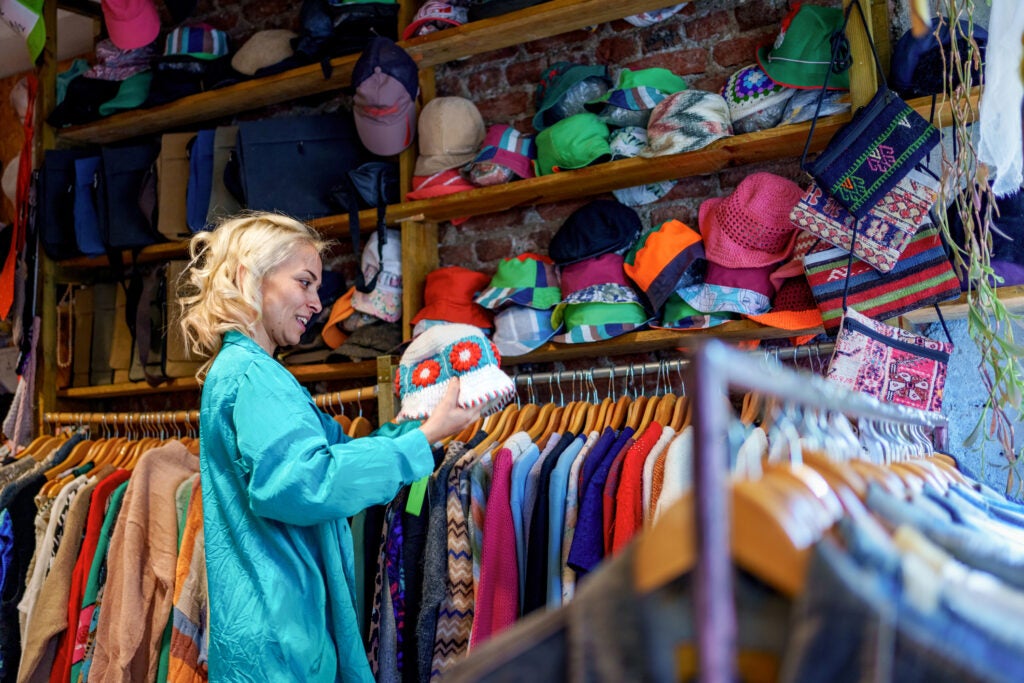Key takeaways
- Thrifting is a way to save money while spending on discretionary items like clothes and furniture.
- In light of recession worries, more Americans are opting for secondhand shopping and cheaper brands.
- Certain credit cards offer cash back or travel rewards when you shop at thrift stores, online resellers and more.
Many of us enjoy the feeling of retail therapy. Whether it’s designer bags or backpacking gear, we love buying that shiny object in the store or receiving it on our front porch. It’s a temporary hit of dopamine.
Nearly 2 in 5 Americans (38 percent) would go into debt for a discretionary purchase, according to Bankrate’s 2024 Discretionary Spending Survey.
But with the recent tariff activity and a 1 in 3 chance of a recession, some people are getting serious about spending.
Research from Smarty shows that 2 in 5 Americans (40 percent) would switch to a cheaper brand and half (50 percent) would consider secondhand alternatives while bracing for economic change.
And as we celebrate Earth Day, there are environmental impacts to consider, too. Learn more about how thrifting can help your wallet — and the world — and which credit cards to swipe at your local consignment shop.
What is thrifting and how does it help your budget?
Thrifting — or secondhand shopping — is when you buy used items for a fraction of the cost. A lucky thrift shopper can also find new items with tags or in the original box.
I secondhand shop in a number of ways — at thrift stores, estate sales, clothing swaps and online markets like Depop and Facebook Marketplace. One year, I even set a resolution to only buy secondhand items to the extent I could. This lifestyle choice has saved me thousands of dollars in clothing, furniture and other goods.
Turns out, I might be onto something. Capital One Shopping reports that thrift shoppers save an average of $1,760 per year.
Shannon Martin, Bankrate writer, recently bought secondhand desks for her daughters. She originally planned to go to the nearest Ikea, which is a 30-45 minute drive to Canada for her. However, in light of concerns about the border and rising prices, she began searching on Facebook Marketplace instead.
“Over the weekend, tons of furniture popped from people who said they were downsizing or had bought replacements ahead of the tariffs,” Martin says. “We got two nice desks and a dresser for $100.”
Only 16 to 18 percent of Americans shop at thrift stores now, according to Capital One’s research, but secondhand apparel sales are on the rise and expected to increase 11 percent annually until 2028. If you’re eyeing your bank accounts and navigating a fluctuating economy, here’s how secondhand shopping can help your budget.
How to spend less by shopping secondhand
A budget consists of two main things — income and expenses. In the face of economic hardship and even debt, you may have to increase one (income) or lower the other (expenses). Some people start a side hustle to pay off debt. Others cut costs by canceling subscriptions, dining out less, comparing insurance rates, reducing utility bills, changing travel plans and bargain shopping.
The best way to keep track of these changes is with a monthly budget. By divvying out your income among monthly spending categories, you can make sure you’re not spending more than you earn. After subtracting fixed costs — like rent, utilities and food — from your budget, the money left over is available for saving, debt payoff and discretionary expenses. Clothing, furniture and other thriftable goods are often in that third category. Shopping secondhand for a portion of your fun budget can help you spend less.
By reducing the discretionary slice of the pie, you’ll have more money left to put toward an emergency fund or credit card debt repayment — and both of these matter during times of uncertainty.
How does thrifting help the environment?
In anticipation of Earth Day on April 22, it’s also worth considering the social responsibility of secondhand shopping. The majority of shoppers (85 percent) view thrifting as good for the environment, according to Capital One Shopping.
Buying pre-owned clothing and household items helps the environment in more ways than one. It reduces demand for new items, which require natural resources and labor — sometimes unethically so — to produce. It keeps items out of landfills as they land in your closet and living areas instead. And it lessens your carbon footprint by around 25 percent, as Capital One Shopping reports.
Trends like underconsumption and deinfluencing also resist traditional consumerism. Some people might be keeping up with the Joneses, but others are buying less and unfollowing social media influencers who push goods on their followers.
Credit cards for thrifting
If you’re a regular thrift shopper or ready to become one, it helps to have a credit card that rewards your spending habits. Here are a few picks for credit cards for thrift shopping.
Best for thrift store rewards
Best for household items
Best for flat-rate cash back
Best for flat-rate travel rewards
The bottom line
If you’re worried about money because of macroeconomic factors or personal budget items like your income or debt, you’re not alone. Around 2 in 3 Americans with credit card debt have had to delay a financial step, like saving or investing, according to Bankrate’s 2025 Dealing With Debt Survey. Secondhand shopping is one way to reduce expenses without sacrificing style. And you can put those savings toward paying down debt and preparing for an emergency — or recession.
The information about the Wells Fargo Attune℠ Card has been collected independently by Bankrate.com. The card details have not been reviewed or approved by the card issuer.
Information about Bank of America products was last updated on April 15, 2025.
Read the full article here










